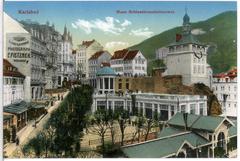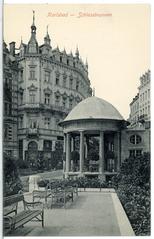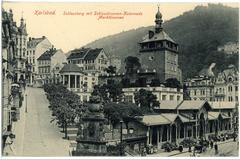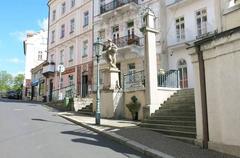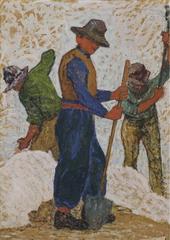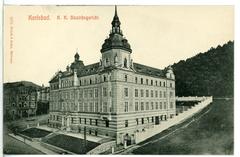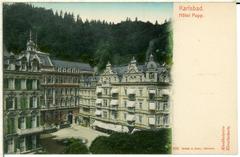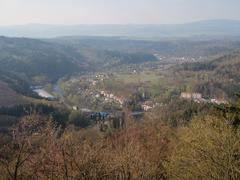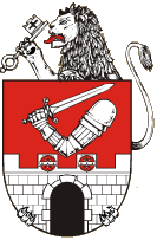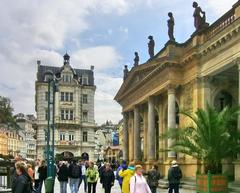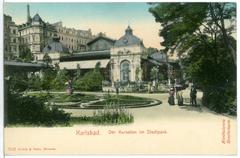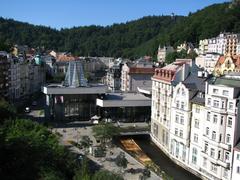
Visiting Zámecká kolonáda in Karlovy Vary: History, Tickets, and Tips
Date: 01/08/2024
Introduction
Welcome to Karlovy Vary, the spa capital of the Czech Republic, where history, architecture, and wellness harmoniously blend. One of the most iconic landmarks in this picturesque town is the Zámecká kolonáda, or Castle Colonnade. This historic site is a testament to Karlovy Vary’s rich spa tradition, dating back to the 18th century. The first recorded emergence of the Zámecký pramen (Castle Spring) was in 1769, thanks to the efforts of David Becher, a local physician who recognized the therapeutic potential of the spring’s mineral waters (Karlovy Vary). Over the centuries, the site has undergone significant architectural transformations, from its initial wooden pavilion in 1797 to the magnificent Art Nouveau colonnade designed by Johann Friedrich Ohmann in the early 20th century (Karlovy Vary). Today, Zámecká kolonáda stands as a symbol of the town’s enduring spa culture, offering visitors a chance to experience its historical and architectural splendor. This comprehensive guide will delve into the history, architectural significance, visiting hours, ticket information, and more to ensure you make the most of your visit to Zámecká kolonáda.
Table of Contents
- [Exploring Zámecká kolonáda in Karlovy Vary](#exploring-zámecká-kolonáda-in-karlovy-varyexploring-zámecká-kolonáda-in-karlovy-vary)
- [Historical Background](#historical-backgroundhistorical-background)
- [Early Discovery and Initial Development](#early-discovery-and-initial-developmentearly-discovery-and-initial-development)
- [Architectural Evolution in the 19th and Early 20th Centuries](#architectural-evolution-in-the-19th-and-early-20th-centuriesarchitectural-evolution-in-the-19th-and-early-20th-centuries)
- [Modern Renovations and Current Use](#modern-renovations-and-current-usemodern-renovations-and-current-use)
- [Visitor Information](#visitor-informationvisitor-information)
- [Ticket Prices and Visiting Hours](#ticket-prices-and-visiting-hoursticket-prices-and-visiting-hours)
- [Accessibility and Travel Tips](#accessibility-and-travel-tipsaccessibility-and-travel-tips)
- [Nearby Attractions](#nearby-attractionsnearby-attractions)
- [Significance in the Spa Tradition of Karlovy Vary](#significance-in-the-spa-tradition-of-karlovy-varysignificance-in-the-spa-tradition-of-karlovy-vary)
- [Architectural Highlights and Visitor Experience](#architectural-highlights-and-visitor-experiencearchitectural-highlights-and-visitor-experience)
- [Preservation and Cultural Impact](#preservation-and-cultural-impactpreservation-and-cultural-impact)
- [FAQ](#faqfaq)
- [Conclusion](#conclusionconclusion)
- [References](#referencesreferences)
- [Historical Background](#historical-backgroundhistorical-background)
Exploring Zámecká kolonáda in Karlovy Vary
Historical Background
Early Discovery and Initial Development
The history of Zámecká kolonáda, also known as the Castle Colonnade, is deeply intertwined with the rich spa tradition of Karlovy Vary. The first recorded emergence of the Zámecký pramen (Castle Spring) dates back to 1769, located beneath the Castle Tower in the historic center of Karlovy Vary. The utilization of this mineral spring for therapeutic purposes was proposed by the local physician David Becher, who conducted a chemical analysis of the spring water, highlighting its potential health benefits (Karlovy Vary).
In 1797, the first pavilion was constructed over the Castle Spring, marking the beginning of its architectural evolution. However, in 1809, a significant event occurred when the eruption of the Vřídlo geyser caused the spring to disappear, only to re-emerge 14 years later. By 1830, a new wooden colonnade designed by architect Josef Esch was added to the site, enhancing its appeal and functionality (Karlovy Vary).
Architectural Evolution in the 19th and Early 20th Centuries
The late 19th and early 20th centuries saw significant architectural advancements in the development of Zámecká kolonáda. Between 1910 and 1912, a new Art Nouveau colonnade was constructed by the Karlovy Vary builder Friedrich Seitz, based on the designs of the renowned Viennese architect Johann Friedrich Ohmann. This new structure comprised three distinct sections: the Lower Castle Spring Colonnade, the Sun Baths, and the Upper Castle Spring Colonnade. The aim was to create a cohesive promenade area that connected the Castle Spring with the Market Colonnade (Karlovy Vary).
In 1913, the backdrop of the Lower Castle Spring was adorned with a monumental Art Nouveau relief of the Spirit of the Springs, sculpted by the Viennese artist Wenzel Hejda. This addition further enhanced the aesthetic and cultural significance of the colonnade (Karlovy Vary).
Modern Renovations and Current Use
The turn of the 21st century brought about necessary renovations to preserve the historical and functional integrity of Zámecká kolonáda. Between 2000 and 2001, the deteriorating structure underwent extensive refurbishment under the guidance of architect Alexander Mikoláš. The project transformed the colonnade into a comprehensive spa facility known as Zámecké lázně (Castle Spa). Today, the facility is accessible exclusively to spa clients, with the Upper Castle Spring pavilion remaining open to the public. The Lower Castle Spring has been redirected to the Market Colonnade (Karlovy Vary).
Visitor Information
Ticket Prices and Visiting Hours
Visitors interested in exploring Zámecká kolonáda should be aware of the ticket prices and visiting hours. While the Upper Castle Spring pavilion is open to the public, access to the Zámecké lázně (Castle Spa) is restricted to spa clients. For the latest ticket prices and visiting hours, it is recommended to check the official Karlovy Vary website.
Accessibility and Travel Tips
Zámecká kolonáda is located in the historic center of Karlovy Vary, making it easily accessible by foot from most parts of the town. For those traveling by car, parking facilities are available nearby. Public transportation options, including buses and taxis, are also accessible. Visitors should wear comfortable walking shoes and consider bringing a water bottle to stay hydrated while exploring the colonnade and its surroundings.
Nearby Attractions
In addition to Zámecká kolonáda, Karlovy Vary offers a wealth of attractions for visitors. Nearby sites include the Market Colonnade, Mill Colonnade, and the Hot Spring Colonnade. Each of these locations provides unique architectural and historical insights into the town’s rich spa tradition. Visitors can also enjoy the scenic beauty of the nearby parks and the Teplá River.
Significance in the Spa Tradition of Karlovy Vary
Karlovy Vary, often referred to as the “spa capital” of the Czech Republic, boasts a unique collection of mineral springs that have attracted visitors for centuries. The town’s spa tradition dates back over 600 years, with Zámecká kolonáda playing a pivotal role in this heritage. The colonnade’s historical and architectural significance, combined with the therapeutic properties of its mineral springs, make it a cornerstone of Karlovy Vary’s spa culture (We Drink Eat Travel).
Architectural Highlights and Visitor Experience
Visitors to Zámecká kolonáda can appreciate its architectural beauty and historical context. The colonnade’s Art Nouveau design, characterized by intricate details and elegant forms, reflects the artistic trends of the early 20th century. The relief of the Spirit of the Springs is a notable feature, symbolizing the natural and cultural essence of Karlovy Vary’s spa tradition (Karlovy Vary).
For those exploring the colonnade, the experience is enhanced by the opportunity to taste the mineral-rich waters of the Castle Spring. The unique composition of these waters, with their distinct earthy flavors, offers a sensory connection to the town’s therapeutic heritage (We Drink Eat Travel).
Preservation and Cultural Impact
The preservation of Zámecká kolonáda is crucial for maintaining the historical and cultural fabric of Karlovy Vary. The colonnade not only serves as a functional spa facility but also as a testament to the town’s architectural and therapeutic legacy. Efforts to maintain and restore such structures ensure that future generations can continue to experience and appreciate the rich history of Karlovy Vary’s spa tradition (Karlovy Vary).
Conclusion
In conclusion, the historical background of Zámecká kolonáda is a narrative of discovery, architectural evolution, and cultural significance. From its early days in the 18th century to its modern-day role as a premier spa facility, the colonnade remains a vital part of Karlovy Vary’s identity. Visitors to this historic site can immerse themselves in the town’s rich spa heritage, experiencing both the therapeutic benefits and the architectural splendor that define Zámecká kolonáda.
FAQ
Q: What are the visiting hours for Zámecká kolonáda?
A: Visiting hours for the Upper Castle Spring pavilion vary, and it is recommended to check the official Karlovy Vary website for the most up-to-date information.
Q: How much are the tickets for Zámecká kolonáda?
A: Ticket prices for the Zámecké lázně (Castle Spa) are available on the official website. The Upper Castle Spring pavilion is open to the public, but the spa facilities require a ticket.
Q: Is Zámecká kolonáda accessible for people with disabilities?
A: Yes, Zámecká kolonáda is accessible for people with disabilities. There are ramps and accessible pathways to ensure that all visitors can enjoy the site.
Q: What other attractions are near Zámecká kolonáda?
A: Nearby attractions include the Market Colonnade, Mill Colonnade, and the Hot Spring Colonnade, along with scenic parks and the Teplá River.
Call to Action
Don’t miss out on the opportunity to explore the rich history and stunning architecture of Zámecká kolonáda. Download our mobile app Audiala for more travel guides and tips, and follow us on social media for updates on the best historical sites to visit!
References
- Karlovy Vary. (n.d.). Historie Zámecké kolonády. Retrieved from Karlovy Vary
- We Drink Eat Travel. (n.d.). 20 of the Best Things to Do in Karlovy Vary. Retrieved from We Drink Eat Travel
- Amazing Czechia. (n.d.). Karlovy Vary. Retrieved from Amazing Czechia
- My Czech Republic. (n.d.). Cities: Karlovy Vary - Colonnades. Retrieved from My Czech Republic


